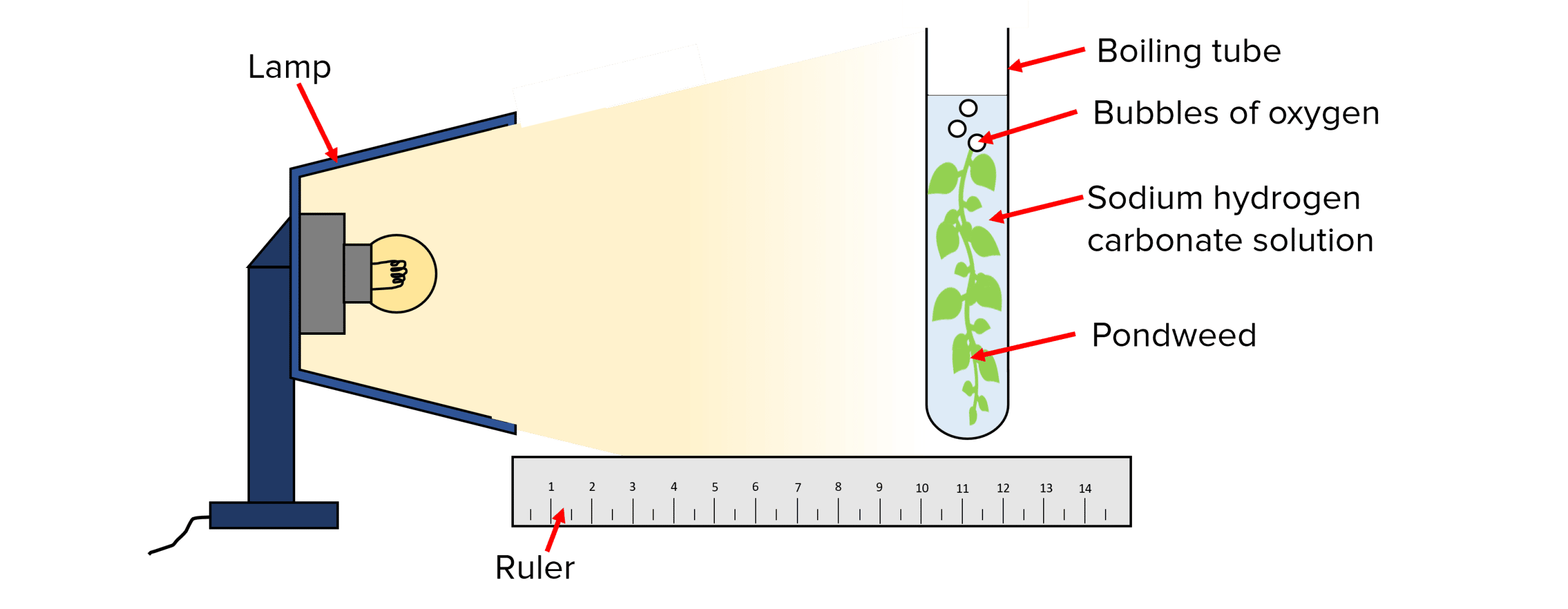Rate of Photosynthesis
Rate of Photosynthesis Revision
Rate of Photosynthesis
The effects of temperature, light intensity and carbon dioxide concentration on the rate of photosynthesis can be represented graphically. These graphs can show how the different factors interact and help to identify which is the limiting factor. You can determine the rate of photosynthesis of a plant experimentally and investigate how this changes at different light intensities.
Temperature

As with most biological reactions, photosynthesis uses enzymes.
Increasing the temperature will increase the rate of photosynthesis up to a certain temperature because the enzymes will have more kinetic energy and are therefore more likely to successfully collide with the substrate. This means that temperature is the limiting factor.
When it reaches the optimum temperature, the enzymes are most active and the rate of photosynthesis is at its highest – temperature is not the limiting factor.
Temperature becomes the limiting factor once again when raised above the optimum because the enzymes will start to denature.
Light Intensity

Energy in the form of light is required for photosynthesis to occur.
If the light intensity is too low, it becomes the limiting factor. Increasing the light intensity will increase the rate of photosynthesis up to a point.
At this point, the rate will no longer increase with increasing light intensity because other factors will be limiting it, such as temperature and carbon dioxide concentration.
Carbon Dioxide Concentration

Plants require carbon dioxide to photosynthesise.
If the carbon dioxide concentration is too low, it becomes the limiting factor. In order to increase the rate of photosynthesis, carbon dioxide concentration must be increased.
After a certain point, increasing the carbon dioxide concentration will not increase the rate of photosynthesis because other factors will become limiting.
Interacting Limiting Factors

More than one factor can influence the rate of photosynthesis.
The graph on the right shows the effect of both temperature and light intensity on the rate of photosynthesis.
Increasing the light intensity increases the rate of photosynthesis up to a point. When the lines begin to level off, light intensity is no longer limiting.
However, low temperature can also limit the rate of photosynthesis. The 10\text{°C} line levels off at a much lower rate that the 20\text{°C} line.
Required Practical
Investigating the effect of light intensity on rate of photosynthesis.
It is easy to identify if a piece of pondweed is photosynthesising because they release oxygen gas that forms visible bubbles in water or solution. The more bubbles produced, the more oxygen produced and the faster the rate of photosynthesis.
Light intensity can be altered by moving a light source closer and further away from the plant; the greater the distance, the lower the light intensity.
Doing the experiment
- Place a piece of freshly cut pondweed in a boiling tube filled with sodium hydrogen carbonate solution.
- Place the boiling tube 10\text{ cm} away from a lamp.
- Switch the light on and leave for 5 \text{ minutes}, bubbles should start appearing from the end of the pondweed.
- Start the stopwatch and count and record the number of bubbles produced in 1\text{ minute}.
- Repeat the count at this distance twice more in order to calculate the mean number of bubbles per minute.
- Repeat the experiment with the boiling tube at different distances from the lamp.

It is important to ensure the temperature of the solution stays the same throughout the investigations, unaffected by the distance from the lamp, because increasing the temperature will increase the rate of photosynthesis. This can be achieved by:
- Using an LED bulb as they release less heat.
- Putting a glass tank full of water between the lamp and plant to prevent the contents of the boiling tube being heated.
It is also important to control the carbon dioxide concentration by using the same concentration of sodium hydrogen carbonate solution and using the same piece of pondweed/same sized pondweed each time.
To get more accurate results, the oxygen bubbles can be collected using an inverted funnel and the volume of gas can be measured using a syringe.

Plotting a graph
A graph can be plotted to show that the further the distance from the lamp, the lower the rate of bubble production.
Calculating Light Intensity
In the above required practical, we assume that the greater the distance from the lamp , the lower the light intensity. However, this relationship is not linear.
Distance and light intensity are actually linked through the inverse square law:
\text{Light intensity} ∝ \dfrac{1}{\text{Distance}^2}
This symbol,’ ∝‘, means proportional to.
Example: A student is doing an experiment to investigate the effect of different light intensities on the rate of photosynthesis of a piece of pondweed. Calculate the light intensity when a lamp is placed 20\text{ cm} away from the pondweed.
\text{Light intensity} = \dfrac{1}{\text{Distance}^2}
\text{Light intensity} = \dfrac{1}{\text{20}^2}
\text{Light intensity} = 0.0025
Rate of Photosynthesis Example Questions
Question 1: Explain the effect of carbon dioxide concentration on the rate of photosynthesis.
[3 marks]
- If carbon dioxide concentration is too low it becomes limiting.
- Increasing the carbon dioxide concentration increases the rate of photosynthesis.
- After a certain point, other factors will become limiting, rate of photosynthesis will no longer increase with increasing carbon dioxide concentration.
Question 2: When investigating the effect of light intensity on rate of photosynthesis it is important to keep the temperature the same throughout. Why is this and how can it be achieved experimentally?
[2 marks]
Increasing the temperature, increases the rate of photosynthesis.
Any 2 from:
- Use LED Bulb
- Place a tank of water between light and plant.
Question 3: Calculate the difference in light intensity between a lamp that is 30\text{ cm} away and a lamp that is 40\text{ cm} away.
[3 marks]
\text{Light intensity at }40\text{ cm} = \dfrac{1}{40^2}=0.000625
\text{Difference}=0.00111-0.000625=0.000486






